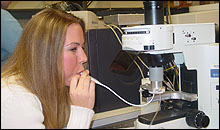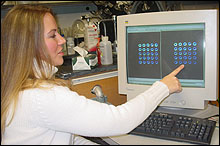Archives
Chemical sensors sniff out disease
Device detects biomarkers for diseases that are in human breath
By ELLEN GOLDBAUM
Contributing Editor
How do you create a sensor that can "sniff" out diseases based on the highly complex odors that come out of our mouths?

You base it on the real thing, according to UB researchers.
They are developing a rugged, inexpensive Breathalyzer-type device that, just like the nose of a human—or other mammal—will contain thousands of chemical sensors "trained" to recognize complex chemical patterns, some of which are known biomarkers for certain diseases.

Rachel M. Bukowski, a doctoral student
in chemistry, demonstrates how the UB device would work. In the top
photo, Bukowski breathes into the machine. In the bottom photo, she can
see on the computer screen the concentration of oxygen in her
breath.
PHOTOS: ELLEN GOLDBAUM
"These volatile biomarkers are free for the asking and taking," said Frank V. Bright, UB Distinguished Professor in the Department of Chemistry in the College of Arts and Sciences, A. Conger Goodyear Professor of Chemistry and principal investigator. "They emanate from us all of the time. They are large in volume, much safer to handle than biofluids and available through totally noninvasive means."
Called gaseous metabolites, these are the same odors that some animals use to identify their offspring, owners, mates, prey or competitors.
So far, multiple volatile chemicals have been detected by other scientists as biomarkers, correlating their presence and concentration with human diseases ranging from diabetes and AIDS to lung cancer and various mental illnesses.
But current methods of detecting these chemicals in human breath and other odors require cumbersome and elaborate laboratory instruments, such as gas chromatographs, which would be prohibitively expensive and inappropriate for clinical, home or remote field settings.
That's why the UB team is taking a multidisciplinary approach, integrating research in neural networks, pattern analysis, novel sensor technologies, low-power optical detectors and light sources with clinical expertise.
Such a speedy, inexpensive tool for early screening of multiple diseases could improve dramatically the health and longevity of millions of Americans, especially the elderly, and those in lower-income groups, in whom diseases often are diagnosed at later stages, Bright said, in part due to economic issues and poor health-screening tools.
The UB team, members of which have developed some of the world's most stable and robust sensors, including some that do not need any calibration for more than two years, may be the first to integrate chemists, clinicians, computer scientists and engineers to exploit the full potential of expired gases or odors from human breath or other parts of the body to diagnose diseases.
Based in UB's Center for Unified Biometrics and Sensors (CUBS), the research, recently funded by a $400,000 grant from the John R. Oishei Foundation of Buffalo, is in the emerging field of metabolomics, the real-time study of metabolites, substances produced through metabolism.
Metabolomics technology has been identified as a focus for research in the National Institutes of Health Roadmap initiative; within the next two years, NIH plans to establish centers and programs in metabolomics.
While there are other electronic "noses" already on the market, they cannot correlate reliably their read-outs to a particular disease state, Bright said.
"The UB device will be unique because it will be designed to exploit, and in some ways mimic, the concepts of olfaction," he continued. "Despite the fact that we might encounter numerous really smelly things in our lifetime, it is not as if there are billions of discrete sensors within our noses that nature designed a priori to respond selectively to every possible smelly odor.
"Rather, there are suites of receptors in our nasal passages and the collective response from all of these receptors to an odor or set of odors can be discriminated," he said.
In the same way, the UB device will contain individual chemical sensors, perhaps as many as a million, that collectively will produce a pattern revealing the chemical signature of a patient's breath, which may be related to a particular disease state.
That pattern then will be used to "train" neural networks, groups of connected artificial neurons capable of learning new information, to discriminate potentially between patients with specific diseases.
"The power of neural networks in this research is that they will pull out the important features and save them so that when they are exposed to a chemical pattern they have 'seen' before, the device will elicit the right response," said Albert H. Titus, assistant professor of electrical engineering in the School of Engineering and Applied Sciences and a co-investigator on the project.
He added that with neural network processing, the size of the sensor elements can stay very small, each measuring about 10 micrometers in size, a critical element for the inexpensive, low-power device the UB team is designing.
Titus is building novel, complementary metal oxide semiconductor (CMOS) arrays that simultaneously will read the signals produced by each of the sensor elements.
"The issue with this application is can you come up with a unique ensemble of sensor elements that exhibit enough diversity to respond to a large variety of small, chemically similar species to give you a chance of realizing the chemical fidelity that you need?" asked Bright.
To achieve that fidelity, he said the chemical sensors will be made out of xerogels, porous glass-like materials that consist of easily tailored nanoscopic pores, which can be tuned to recognize specific chemicals or classes of chemicals.
Bright's lab is well-known for its work developing chemical sensors out of xerogels that detect chemicals in blood, urine and other samples.
So far, he and his associates have developed xerogels that can respond to about 100 different chemicals, ranging from small molecules like oxygen and carbon dioxide, to mid-sized molecules like steroids and prostaglandins, up to big proteins like interleukins.
Bright explained that the envisioned device will work as follows: As the breath sample flows through the breath-testing device, the individual sensing elements will change their color or intensity; those changes will be detected by the CMOS array, producing electrical signals that then can be processed by the neural network.
The ultimate goal is to produce an extremely robust and reliable, low-cost, handheld device encompassing all of the sensing, detection and processing elements.
In addition to Bright and Titus, co-investigators include Alexander N. Cartwright, professor of electrical engineering, and Venu Govindaraju, director of CUBS and professor of computer science and engineering, both in the School of Engineering and Applied Sciences, and Wesley L. Hicks Jr., professor of otolaryngology and neurosurgery in the School of Medicine and Biomedical Sciences and attending surgeon at Roswell Park Cancer Institute.
"The Oishei Foundation's generosity will enable our team to have a prototype ready for clinical testing within a year," said Bright.
The clinical testing will be done at Roswell Park.
